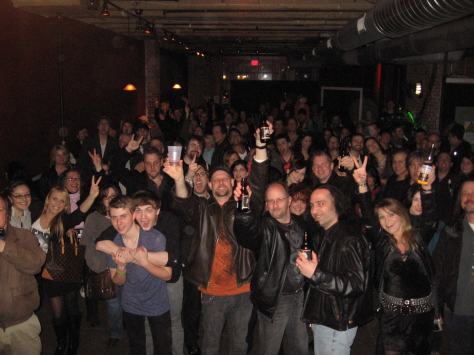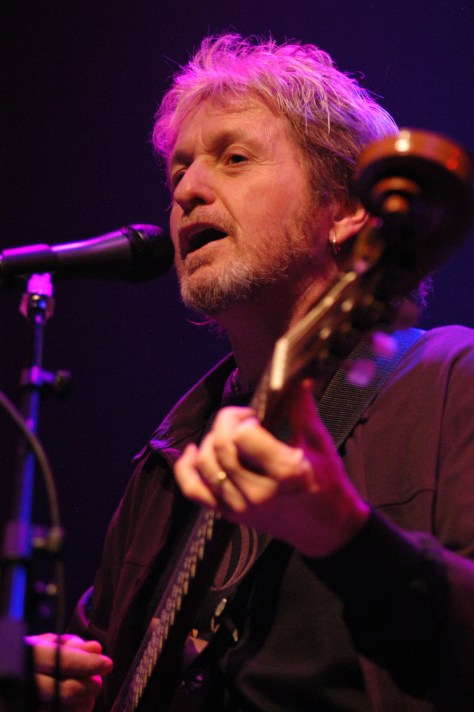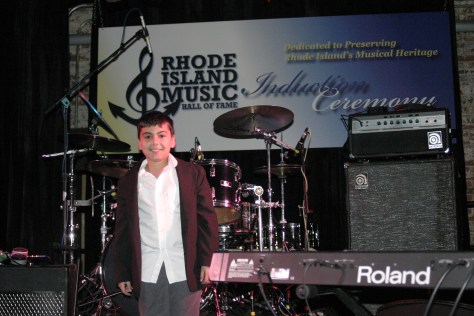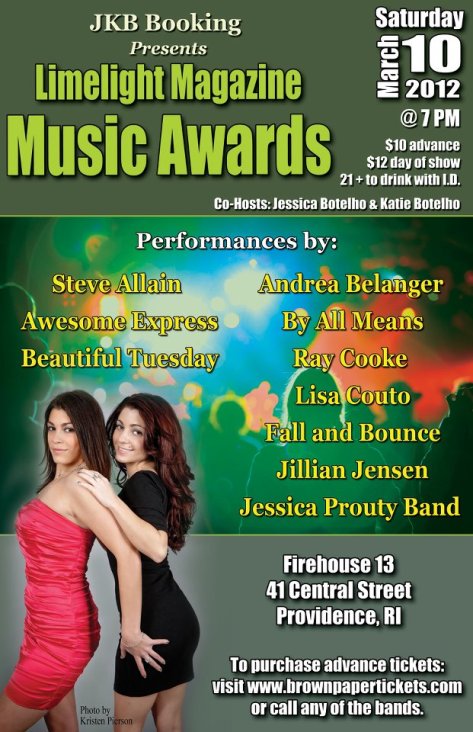By JESSICA A. BOTELHO
When he’s not playing guitar for the Carl Palmer Band or touring with Neal Morse, Paul Bielatowicz spends his time writing. In fact, he is a columnist for two British magazines, Guitar and Guitar Techniques, and has two guitar instruction books scheduled for release this year.
He said the first book charts the evolution of electric guitar playing, while providing tips on how to emulate their styles. Many of the guitarists featured are legendary artists who inspired him through the years, including Eric Clapton, Eddie Van Halen and Nuno Bettencourt. Bielatowicz shows how they influenced each other, with each chapter charting one player to the next.
“It’s kind of like a rock guitarists’ family tree,” he said. “The second book, which is coming out later in the year, is based around the same idea but uses the evolution of technique rather than style.”’
Bielatowicz, who taught guitar at Brighton Institute of Modern Music in the U.K. but gave up teaching the summer of 2010 when touring and recording began to dominate his life, dedicated the last chapter of both books to his readers, as he feels they are an additional link in the chain of guitar evolution. The point, he said, is for readers to take ideas from other guitarists and use it to create their own voice on the instrument.
Moreover, Bielatowicz also kept an online blog when The Carl Palmer Band did a U.S. tour in the summer of 2006.
“It helps me remember the experience and allows me to share a glimpse of ‘behind the scenes life’ with fans,” he said. “Two-thousand eleven was the first U.S. tour I didn’t keep a diary for, and I was surprised by how many people said they really missed it. I had no idea people had enjoyed it so much. Knowing that, I’ll definitely be doing it again.”
Bielatowicz became a member of Palmer’s band in 2003 when Palmer was on the prowl for a guitarist. Palmer asked friends for a few suggestions and guitarist Guthrie Govan recommended Bielatowicz.
But, before he hit the road with Palmer, he needed to learn guitar parts that were contrived from Keith Emerson’s keyboard arrangements, as much of the music was recreations of Emerson, Lake and Palmer material. Palmer gave him copies of the band’s live CDs and a three-month learning process began.
“It was probably the most intense study period I’ve ever had,” Bielatowicz said. “I remember transcribing stuff on Christmas day – that’s how much the pressure was on. Since then, I’ve done all the arranging of new tunes myself, and that’s actually been a lot easier for me because it’s meant that I’ve been able to arrange everything in a way that plays to my strengths as a guitarist. As every artist knows, that is the secret to sounding good.”
Through touring with Palmer, Bielatowicz got the opportunity to play guitar for Neal Morse, a multi-instrumentalist and progressive rock composer, who is also known for his Christian-rock background. Bielatowicz said Morse is one of his heroes and he was surprised and honored when the composer asked him to join him on tour.
“I couldn’t believe my luck,” said Bielatowicz. “Playing with him is amazing. I don’t say this lightly, but Neal is a genius. I’ve never worked with anyone like him. He just eats, sleeps and breathes music. No matter how many times I play with him, I’m always in awe.”
While Bielatowicz said he doesn’t share Morse’s faith, he respects him for it. He described Morse as one of the most “emotionally open” people he’s ever met and is impressed he is able to translate that feeling into music.
“He never holds back when he’s performing,” said Bielatowicz. “I’ve done rock festivals with him, playing to audiences of the meanest looking metal heads, and I’ve seen them reduced to tears through the music. That is really quite something. Those moments are some of the most moving I’ve ever experienced.”
When gigging with Morse, Bielatowicz said his role is very different to the role he plays with Palmer’s band. With Morse, he feels like he’s a “smaller ingredient” in a bigger recipe.
For example, on Morse’s last tour, Bielatowicz was part of an eight-piece band, which he said encourages him to play differently than he plays in Palmer’s trio.
“In Carl’s band, I’m the one playing all the melodies, as well as the harmonies, whenever possible,” he said. “A lot of the time, the challenge is to try to play as much as possible in order to fill out the sound. After all, I’m trying to replicate 10 fingers of a keyboard player. In Neal’s band, I’m trying to play as little as possible so I don’t intrude on anyone else’s sonic space.”
As if his resume isn’t impressive enough, Bielatowicz played with guitarist Les Paul, who established the development of the solid-body electric guitar in the 1940s. The two met while he was gigging in New York, as Palmer’s manager, Bruce Pilato, knew Paul and took Bielatowicz to a jazz club where Paul was performing.
“We ended up going into his dressing room before the show to meet him,” Bielatowicz said. “He was in his 90s then, but was still just as sharp and witty as anyone I’ve ever met. As soon as I met him, he told me that I was going to get up and play with him during his show. That was my introduction to New York and I’ve loved it ever since.”
Overall, Bielatowicz enjoys the East Coast. In fact, he said the highlights of last year’s U.S. tour with Palmer were at the Tupelo Music Hall in Londonderry, New Hampshire, and The Narrows Center for the Arts in Fall River, Massachusetts, two shows the band set up with Limelight Magazine’s publisher, JKB Management and Booking.
“I’ve worked with literally hundreds of promoters and booking agents all over the world, but you guys on the East Coast have got something really special with JKB,” said Bielatowicz. “It’s rare I get to meet people who do such a good job and put such care, attention and love into what they do.”
Before he became a successful guitarist, Bielatowicz was interested in something entirely different: gymnastics. When he was five, he said the sport was his “obsession” and he participated in several competitions.
But, he got to a point where he was training four times a week and his body couldn’t handle the stress, as he sustained many injuries. Faced with the choice of either cutting back on training or giving up, he decided put aside gymnastics by the time he was 11, turning to guitar.
“I’d already played around on the guitar since I was seven, but it wasn’t until I gave up gymnastics that I made the conscious decision to really go for it,” Bielatowicz said. “Everyone expected me to be really upset, but instead I just threw all my energy into the guitar and never looked back.”
These days, Bielatowicz plans on writing a solo album, which will focus on playing classical pieces on guitar. He hopes the album will make them sound as if they were written for guitar, while maintaining their originality and integrity.
“I’m using a very simple gear setup-one guitar going directly into an old 70s valve amp with the gain turned down low-in order to give as much of the pure sound of the guitar as possible,” he said. “That’s as back-to-basics as you can possibly get with an electric guitar and that’s the way a classical musician would approach recording.”
He’s also thinking about having a string quartet appear on some of the pieces, yet nothing has been finalized. Further, he’s been discussing different options with a producer.
When he’s not “having tea and scones,” as he resides in Brighton, England, which he described as an “amazing seaside town,” Bielatowicz likes to spend free time running along the seafront. He said he looks forward to time alone.
“It’s just me, the wind, the sea and my iPod,” he said. “It’s great head space and gives me both a mental and physical workout. I’m not sure anybody actually enjoys the pain and discomfort of a morning run, but I find the feeling of pushing yourself on and resisting the urge to stop, fuels determination for achieving everything else in life.”
At the moment, Bielatowicz is proud to be part of Palmer’s band. He’s reveling in the thrill of it all.
“It’s a great honor,” he said. “He’s given me the opportunity to travel the world playing music, which any rock guitarist would dream of. I consider myself very lucky.”

Paul Bielatowicz










